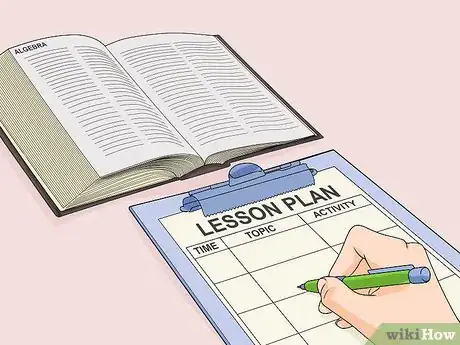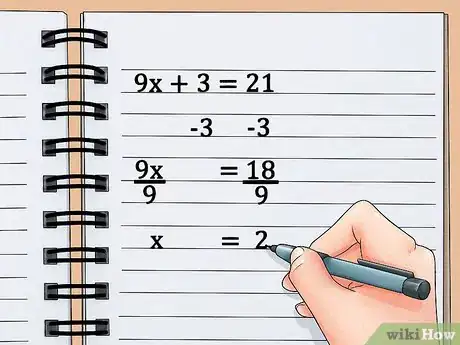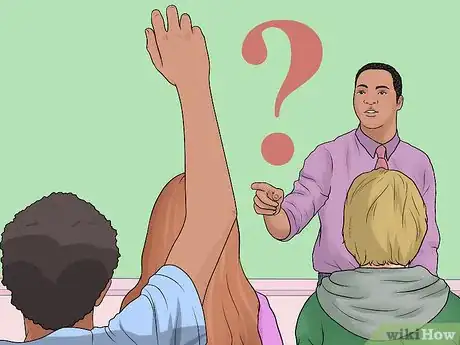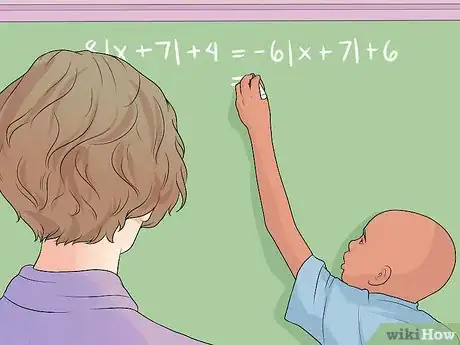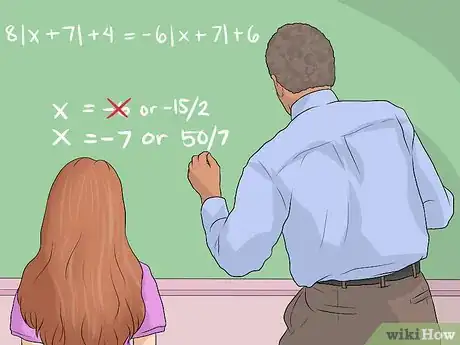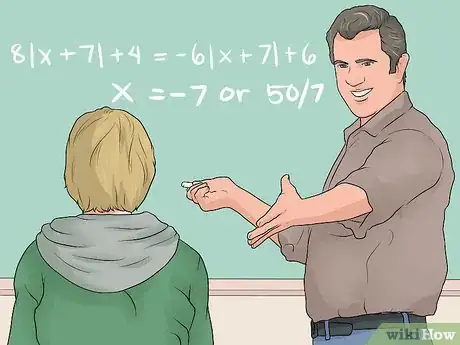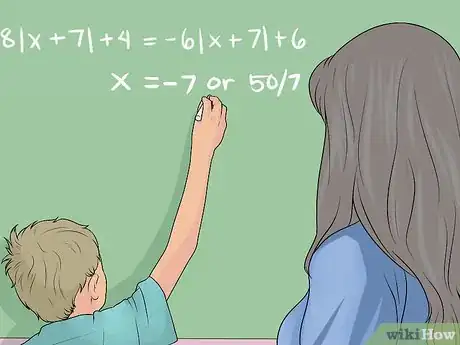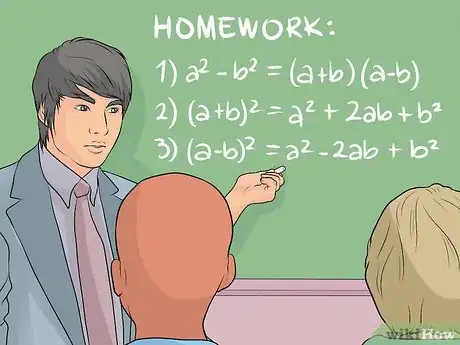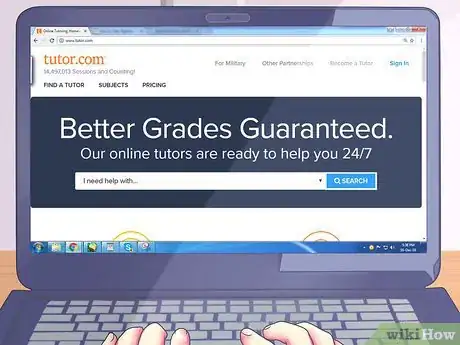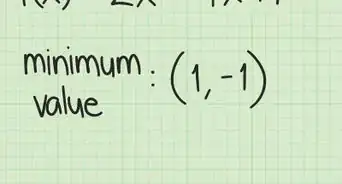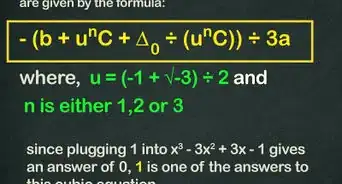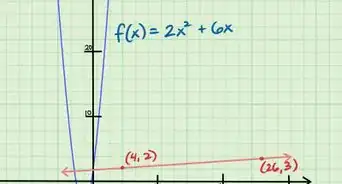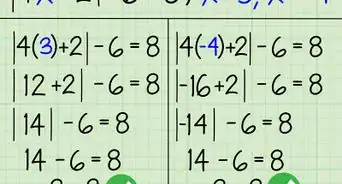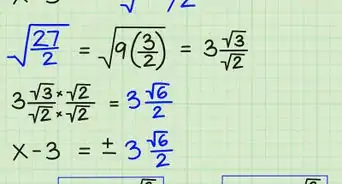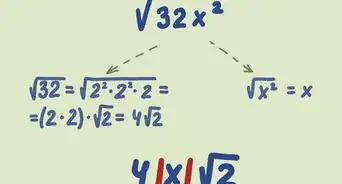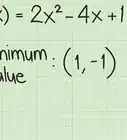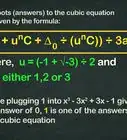This article was co-authored by Sean Alexander, MS. Sean Alexander is an Academic Tutor specializing in teaching mathematics and physics. Sean is the Owner of Alexander Tutoring, an academic tutoring business that provides personalized studying sessions focused on mathematics and physics. With over 15 years of experience, Sean has worked as a physics and math instructor and tutor for Stanford University, San Francisco State University, and Stanbridge Academy. He holds a BS in Physics from the University of California, Santa Barbara and an MS in Theoretical Physics from San Francisco State University.
This article has been viewed 28,631 times.
Many people struggle when it comes to certain mathematics subjects. Algebra is a complicated middle and high school mathematical course. Many kids need extra help with algebra from private tutors. If you’re good at algebra, you can help these students. Learn your subject, plan your session, and provide students the assistance they need to achieve their algebra goals.
Steps
Preparing for Your Students
-
1Know your stuff. This may seem simple, but it’s the most important aspect of any tutoring position. You need to know the subject inside and out. Don’t hesitate to use books, online resources, or your own teachers as resources to brush up on algebra before you begin tutoring students.[1]
-
2Get information from students. When you schedule the tutoring session, be sure to get all the necessary information from the student, so you can provide adequate assistance. Find out what they’re currently studying, what they’ve struggled with in the past, and what their goals are.[2] You should also request access to homework assignments, quizzes, and tests. This will give you a clear idea of where they’re struggling, and how to help.
- Some tutors create a short questionnaire to help them make a good start. This can include all the important data like the student’s name, their availability, and their current course schedule.
- You might want to consider making a quiz for new students. This can help you determine their knowledge level, and better prepare to offer them superior tutoring.[3]
Advertisement -
3Create a lesson plan.[4] Don’t “wing it.” You want to make sure you’re making the most of your time. Make a brief outline of what you’re going to do, how much time each thing should take, and what the student will learn, during each lesson. Continually adjust these expectations based on your student’s progress.[5]
-
4Practice the problems. The last thing you want is to have your student arrive only to discover you can’t actually work the problem. Work through every problem a few times in advance, so you’re certain to be able to offer them guidance as they solve the problem. Remember there is often more than one way to solve the problem, so keep track of the student’s method and give them a chance to find the right answer. Then, walk them through the simplest way to solve.[6]
Conducting Effective Tutoring Sessions
-
1Walk students through your lesson plan. When the student arrives, take a few moments to tell them what you’re going to cover. Make sure they don’t have homework to do or a quiz to prepare for that may be more pressing.[7] Even though you took a great deal of time to prepare for the session, be flexible and accommodate your students whenever possible.[8]
- An example may be saying something such as, “I remember you said you were having trouble with absolute value equations. I thought we could work a few of those together. Then, I’d like you to work a few independently.”
- If the student agrees, you can follow up with something like, “Before we get started, what specific questions about absolute value do you have?”
- You should also double check that there isn’t a more pressing topic they need to cover, “Is absolute value still a topic you’re concerned about now, or do you have upcoming assignment you want to look at first?”
-
2Encourage questions. You may think you’re doing a great job of explaining everything but it’s important to periodically ensure your student is on the same page. Asking students if they have questions, and taking time to answer them seriously is important. Try not to get annoyed or frustrated, if it seems like you’ve answered the same questions for your student. Just encourage them to keep trying. They’ll get there.
- Establish early on that the student should stop you anytime they need to ask a question.
- Avoid saying things like, “Does that makes sense, or do you understand?” This may discourage students who want to impress you or those who don’t want to take more time with the subject by asking for more information.
- Instead, try something like, “Do you have questions?” Better yet, say, “What questions do you have?” This tells the student you expect them to have questions.[9]
-
3Work through a problem together. Now that you’ve established the plan for the day, start by working through a problem together. You can do this a number of different ways, but the goal is to improve students’ confidence in their ability to do the problems, and find out where they will likely need your help.[10] Try:
- Asking the student to tell you what needs to be done, and attempt the problem based on their instructions. Then, make corrections as needed. For instance, in the equation: 8|x + 7| + 4 = -6|x + 7| + 6, the first step should be getting the variables of |x + 7| on the same side of the equation. If the student starts out by saying you need to divide each of the variables by the multiplier, i.e. -6|x + 7|/-6, explain that the equation may be easier if you instead have both 8|x + 7| and -6|x + 7| on the same side of the equation.
- Walking the student through the problem. Let them do the actual figuring on paper or computers as this helps them remember, but tell them each step. In the sample problem above, you would give them the equation and say "The first step is to get both 8|x + 7| and -6|x + 7| on the same side of the equation. How would you do that?"
- Trading the problem back and forth. You start the student down the right track. Then, let them determine what they need to do next. Using the same absolute value equation above, you would get both 8|x + 7| and -6|x + 7| on the left side of the equation. Then, ask the student to complete the next step, getting the +4 and +6 on the same side of the equation by subtracting 4 from both sides. If they do this, you can move forward. If not, explain what they should have done, and continue to the next step. You can trade the problem back and forth in this manner, until it’s done.[11]
-
4Let your student attempt a problem. When you’re done working through one or more problems together, give the student one to work on independently. Let them take as much time as they need to find the solution. Try not to help them with the problem. Even if they get frustrated, just encourage them to keep going until they get an answer (it doesn’t have to be the right answer). This will help the student get used to working through tough problems on their own.[12]
-
5Guide them through corrections. Once the student solves their problem, review it with them. Let them know where they got off course, tell them what the correct method would have been, and make sure to ask them if they have questions for you. This allows them to build independence when it comes to solving problems while continuing to help them improve their algebra skills.[13]
- Take the sample absolute value equation 8|x + 7| +4 = -6|x + 7| + 6. If the student begins the problem by dividing each side by -6 rather than adding 6|x + 7| to each side, they end up with a very different result (x = -6 or -15/2 rather than the correct x = -7 or -50/7), but they can achieve an answer. Let the student solve the problem. Then, walk them back through the equation the correct way.
-
6Ask the student to walk you through the problem. After your student has completed the problem and you’ve reviewed and corrected it, have them start over from the beginning and walk you through how to solve the problem. This gives them the opportunity to rehash what they just learned from a different perspective. If they can accurately explain how to complete the process, they are more likely to retain the information.[14]
-
7Repeat as needed. Have your student work problems until they can solve two or more in a row without error. When they reach this point, you can move on to something new, if you still have time. Otherwise, ask them if they have any questions, and begin planning for your next session.[15]
-
8Assign homework. They might hate their homework, but you really want to make sure they understand the material. If they have an assignment in their class that’s covering the same subject, this may be adequate, so make sure you ask them what their homework is for class. Inform the parent/guardian about their assignment too. If their parents know they have homework from you, they may be more likely to get the work done.[16]
- Even if the students have a great deal of homework, assign them two or three extra equations.
- Ask the student to text or email you a photo of their completed equations as they finish. You can then send feedback letting them know whether or not they’ve gotten the correct answer or need to make another attempt.
-
9Plan your next session. Before the student leaves, schedule your upcoming study time. Ask if there are any tests or assignments coming up that they would like to focus on. If the student pays you directly, you can also obtain payment at this time.
Creating a Business
-
1Seek new clients. Make sure your information is available online. Make a website with contact information, pricing, schedule of when you’re available, and subjects you’re able to tutor. You can also advertise on Craigslist and other websites. Reach out to local middle schools, high schools, community colleges, and universities to ask how you can advertise on their campus.[17]
-
2Join an online tutor community.[18] One great way to get your name out, and get new jobs is to join a tutoring service online. Sites like tutor.com and coursehero.com are great options. The benefit of these services is that you’ll receive training, have easy access to a number of students, and you don’t have to worry about payments since these online communities typically pay you directly. These organizations typically charge a fee, so you may be able to make more money working independently. However, you’ll have to do more work to establish a client base, get paid, and keep up with all the other related business information.
-
3Keep records. Track all of your tutoring hours, what you teach, and what you earn. If you have a problem at any level with a student, your taxes, or any other work-related concerns, keep a record of this as well. While issues are infrequent, it’s important to have records if a student ever complains about your services.[19]
-
4Get certified. If you’re in a very competitive market or you want to set yourself above the competition to earn a higher salary, there are tutoring certification programs online via the American Tutoring Association, the National Tutoring Association, and the College Reading and Learning Association[20] among others. While a certificate is not a requirement to be a tutor, it does look good on your resume or portfolio.
Community Q&A
-
QuestionHow do I tutor someone effectively?
 Sean Alexander, MSSean Alexander is an Academic Tutor specializing in teaching mathematics and physics. Sean is the Owner of Alexander Tutoring, an academic tutoring business that provides personalized studying sessions focused on mathematics and physics. With over 15 years of experience, Sean has worked as a physics and math instructor and tutor for Stanford University, San Francisco State University, and Stanbridge Academy. He holds a BS in Physics from the University of California, Santa Barbara and an MS in Theoretical Physics from San Francisco State University.
Sean Alexander, MSSean Alexander is an Academic Tutor specializing in teaching mathematics and physics. Sean is the Owner of Alexander Tutoring, an academic tutoring business that provides personalized studying sessions focused on mathematics and physics. With over 15 years of experience, Sean has worked as a physics and math instructor and tutor for Stanford University, San Francisco State University, and Stanbridge Academy. He holds a BS in Physics from the University of California, Santa Barbara and an MS in Theoretical Physics from San Francisco State University.
Academic Tutor I find it helpful to break the tutoring session up into sections. Spend a few minutes at the beginning of the session talking to the student to build rapport and figure out what they need help with. Then, work through some algebra problems together. Once they understand the concepts, give them a couple of problems to do on their own without asking questions. Then, you can go over the answers together and figure out what they still need help with.
I find it helpful to break the tutoring session up into sections. Spend a few minutes at the beginning of the session talking to the student to build rapport and figure out what they need help with. Then, work through some algebra problems together. Once they understand the concepts, give them a couple of problems to do on their own without asking questions. Then, you can go over the answers together and figure out what they still need help with.
References
- ↑ http://www.wahm.com/articles/5-mistakes-to-avoid-when-becoming-a-math-tutor.html
- ↑ Sean Alexander, MS. Academic Tutor. Expert Interview. 14 May 2020.
- ↑ https://twiki.math.cornell.edu/pub/MSC/BecomingABetterMathTutor/Becoming_a_Better_Math_Tutor.pdf
- ↑ Sean Alexander, MS. Academic Tutor. Expert Interview. 14 May 2020.
- ↑ http://uncw.edu/ulc/math/howtotutormath.html
- ↑ https://twiki.math.cornell.edu/pub/MSC/BecomingABetterMathTutor/Becoming_a_Better_Math_Tutor.pdf
- ↑ Sean Alexander, MS. Academic Tutor. Expert Interview. 14 May 2020.
- ↑ http://uncw.edu/ulc/math/howtotutormath.html
- ↑ https://twiki.math.cornell.edu/pub/MSC/BecomingABetterMathTutor/Becoming_a_Better_Math_Tutor.pdf
- ↑ Sean Alexander, MS. Academic Tutor. Expert Interview. 14 May 2020.
- ↑ https://twiki.math.cornell.edu/pub/MSC/BecomingABetterMathTutor/Becoming_a_Better_Math_Tutor.pdf
- ↑ Sean Alexander, MS. Academic Tutor. Expert Interview. 14 May 2020.
- ↑ http://uncw.edu/ulc/math/howtotutormath.html
- ↑ http://uncw.edu/ulc/math/howtotutormath.html
- ↑ https://twiki.math.cornell.edu/pub/MSC/BecomingABetterMathTutor/Becoming_a_Better_Math_Tutor.pdf
- ↑ https://twiki.math.cornell.edu/pub/MSC/BecomingABetterMathTutor/Becoming_a_Better_Math_Tutor.pdf
- ↑ http://www.wahm.com/articles/5-mistakes-to-avoid-when-becoming-a-math-tutor.html
- ↑ Sean Alexander, MS. Academic Tutor. Expert Interview. 14 May 2020.
- ↑ http://www.wahm.com/articles/5-mistakes-to-avoid-when-becoming-a-math-tutor.html
- ↑ https://www.crla.net/index.php/certifications/ittpc-international-tutor-training-program



